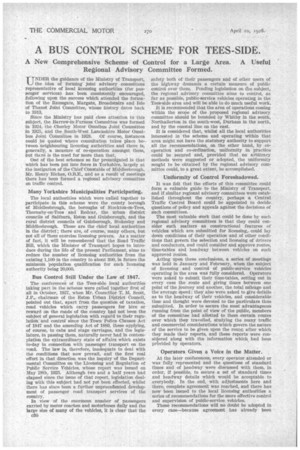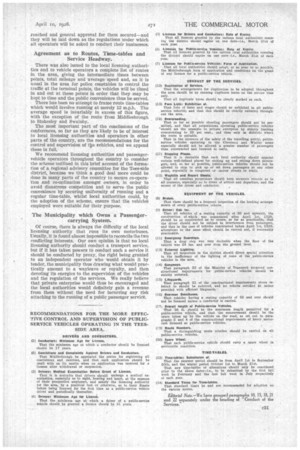A BUS CONTROL SCHEME FOR TEES-SIDE.
Page 52

Page 53

If you've noticed an error in this article please click here to report it so we can fix it.
A New Comprehensive Scheme of Control for a Large Area. A Useful Regional Advisory Committee Formed.
UNDER the guidance of the Ministry of Transport, the Idea of forming joint advisory committees representative of local licensing authorities (for passenger services) has been consistently encouraged, following upon the success which attended the formation of the Ramsgate, Margate, Broadstairs and Isle of Thartet Joint Committee, whose history dates back to 1913,
Since the Ministry has paid close attention to this subject, the Barrow-in-Furness Committee was formed In 1924, the Chorley Motor Omnibus Joint Committee in 1925, and the South-West Lancashire Motor Omni bus Joint Ooratnittee in 1928. Of course, instances could be quoted where consultation takes place between neighbouring licensing authorities and there is, generally, a measure of co-operation amongst them, but tli,re is the need for more than that.
One of the best schemes so far promulgated is that which has been put into force in Yorkshire, largely at the instigation of the Chief Constable of Middlesbrough, Mr. Henry Riches, 0.B.E., and as a result of meetings there has been formed a regional advisory committee on traffic control.
Many Yorkshire Municipalities Participating.
The local authorities which were called together to participate in this scheme were the county borough of Middlesbrough, the boroughs of Stockton-on-Tees, Thornaby-on-Tees and Redcar, the urban district councils of Saltburn, Eaton and Guisborough, and the rural district councils of Guisborough, Stokesley and Middlesbrough. Those are the chief local authorities in the district ; there are, of course, many others, but not all of them exercise licensing powers. As a matter of fact, it will be remembered that the Road Traffic Bill, which the Minister of Transport hopes to introduce during the life ol the present Parliament, aims to reduce the number of licensing authorities from the existing 1,100 in the country to about 300, in future the minimum 'population qualification for such licensing authority being 20,000.
Bus Control Still Under the Law of 1847.
The conferences of the Tees-side local authorities taking part in the scheme were called together first of all in October, 1927, when Mr. Councillor T. M. Scott, J.P.,. chairman of the Eaton Urban District Council, pointed out that, apart from the question of taxation, • road vehicles which carry passengers for hire Or reward on the roads of the country had not been the subject of general legislation with regard to their regulatioh and control" since the Town Police Clauses Act of 1847 and the amending Act of 1880, these applying, of course, to cabs and stage carriages, and the legislature, in passing them, naturally never had in contemplation the extraordinary state of affairs which exists to-day in connection with passenger transport on the road. The law is, therefore, inadequate to deal with the conditions that now prevail, and the first real effort in that direction was the inquiry of the Departmental Committee on the Licensing and Regulation of Publie. Service Vehicles, whose report was issued on May 28th, 1925. Although two and a half years had elapsed since the issue of that report, legislation dealing with this subject had not yet been effected, whilst there has since been a further unprecedented development of passenger road transport services of the country.
In view of the enormous number of passengers carried by motor coaches and motorbuses daily and the large size of many of the vehicles, it is clear that the e30 safety both of their passengers and of other users of the highway demands a certain measure of public control over them. Pending legislation on the subject, the regional advisory committee aims to control, as far as possible, public-service vehicles operating in the Tees-side area and will be able to do much useful work.
It is recommended that the area of operations coming within the scope of the proposed regional advisory committee should be bounded by Whitby in the south, Northallerton in the south-west, Durham in the north, and by the coastal line on the east.
It is considered that, whilst all the local authorities interested in the scheme and operating within that area might not have the statutory authority to support all the recommendations, on the other hand, by cooperation and co-Ordination, uniformity in practice could be secured and, provided that no arbitrary methods were suggested' or adopted, the uniformity sought to be obtained by the regional, advisory comraittee could, to a great extent, be accomplished.
Uniformity of Control Foreshadowed.
It was felt that the efforts of this committee Could form a valuable guide to the Ministry of Transport, and if similar regional advisory committees were established throughout the country, perhaps a Central Traffic Control Board could be appointed to decide questions of policy and appeals against the decisions of such committees.
The most valuable Work that could be done by such regional advisory committees is that they could consider such matters as constructional features of vehicles which are submitted for licensing,. could lay clown conditions of their operation and of other conditions that govern the selection and licensing of drivers and conductors, and could consider and approve routes, time-tables and headway between vehicles on such
approved routes. • Acting upon these conclusions, a series of meetings was held in January and February, when the subject of licensing and control of public-service vehicles operating in the area was fully considered. Operators were asked to submit their time-tables, setting Out in every case the route and giving times between . one point of the journey and another, the total mileage and the average speed; they, also were asked to give details as to the headway of their vehicles, and considerable time and thought were devoted to the particulars thus submitted. In order to secure the most advantageous running from the point of view of the public, members of the committee had allotted to them Certain routes over which they travelled, studying the many traffic and commercial considerations which govern the nature of the service to be given upon the route, after which they made their reports, and these reports were considered along with the information which had been prbvided by operators.
Operators Given a Voice in the Matter.
At the later conferences, every operator. attended or was fully represented and the questions of standard times and of headway were discussed with them, in order, if possible, to secure a set of standard times and headway details which would be acceptable to .everybody. In the end, with adjustments here and there, complete. agreement was reached, and there has now been issued to the local licensing authorities a aeries of recommendations for the more effective control
and supervision, of public-service vehicles, :
These recommendations will no doubt be adopted in every case—because agreement. has already been
reached and general approval for them secured—and they will be laid down as the regulations under which all operators will be asked to conduct their businesses.
Agreement as to Routes, Time-tables and Service Headway.
There was also issued to the local licensing authorities and to vehicle operators a complete' list ofroutes in the area, giving the intermediate times between points, total mileage and -average •speed and, as it is usual in the area for police constables to control the traffic at the terminal points, the vehicles will be timed in and out at these points in order that they may be kept to time and the public convenience thus be served.
There has been no attempt to frame route time-tables -which would involve running at merely 12 m.p.h. The average speed Is invariably in excess of this figure, with the exception of the route from Middlesbrough to Stokesley and Swainby.
The most important part of the conclusions of the conferences, so far as they are likely to be of interest to local licensing authorities and operators in other parts of the country, are the recommendations for the control and supervision of tp vehicles, and we append these in full.
We recommend licensing authorities and passengervehicle operators throughout the country to consider tile scheme butlined in this brief account of the formation of a regional advisory committee for the Tees-side district, because we think a good deal more could be done in luau parts of the country to secure co-operation and co-ordination amongst owners, in order to avoid disastrous competition and to serve the public convenience by securing uniformity of running and a regular time-table, whilst local authorities could, by the adoption of the scheme, ensure that the vehicles employed were suitable for their purpose.
The Municipality which Owns a Passengercarrying System.
Of course, there is always the difficulty of the local licensing authority that runs its own motorbuses. Usually, it is found almost impossible to reconcile the two conflicting interests, Our own opiniOn is that DO local licensing authority should conduct a transport service, but if it has taken powers to conduct such a service it should he conducted by proxy, the right being granted to an independent operator who would obtain it by tender, the municipality thus drawing what would practically amount to a wayleave or royalty, and then devoting its energies to the supervision of the vehicles and the regulation of the services. We really believe that private enterprise would thus be encouraged and the local authorities would definitely gain a revenue from them without the need for incurring any risk attaching to the running of a public passenger service.












































































































